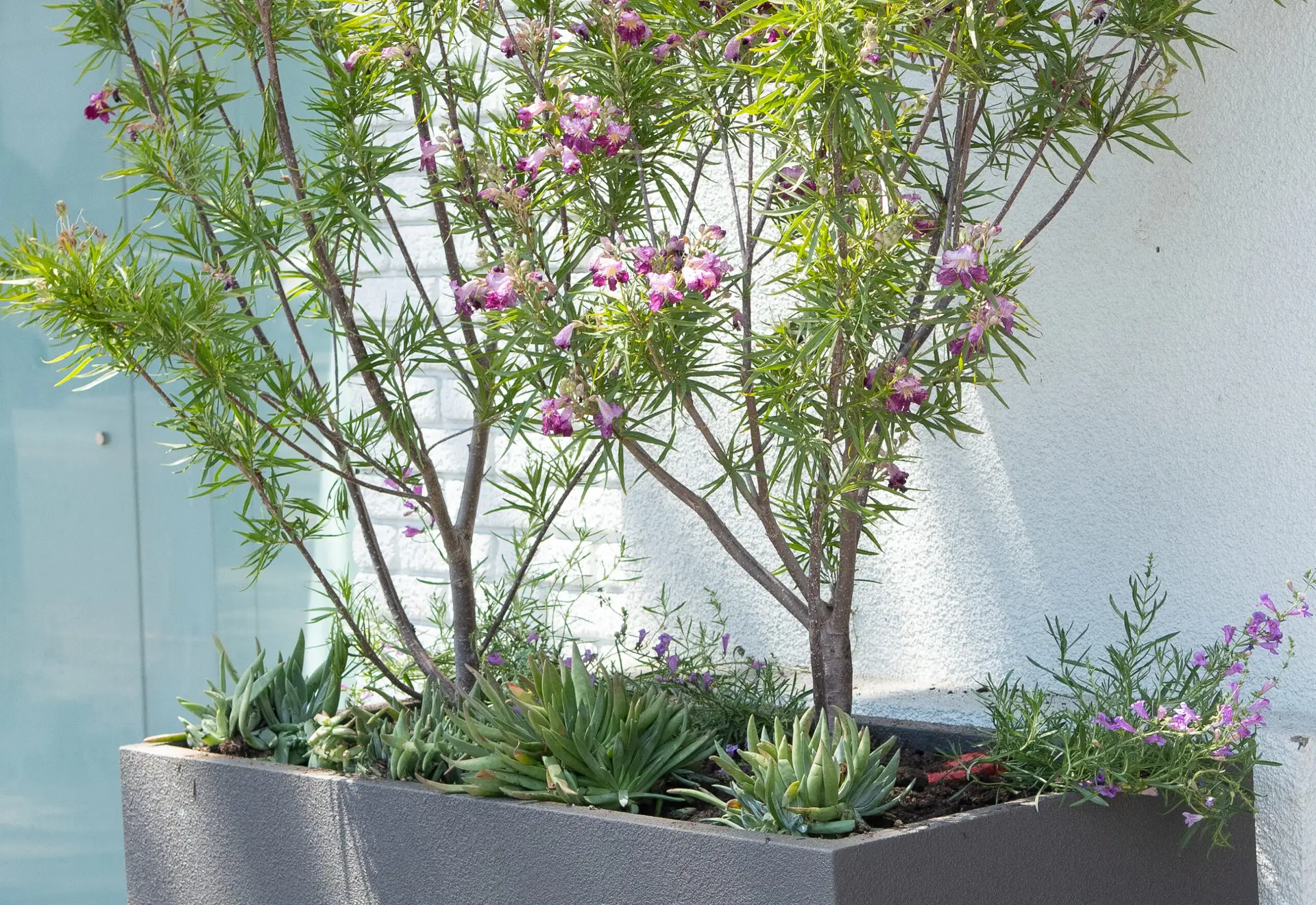SoFA Urban Garden
Located at 452 South First Street
The coastal sage scrub uniquely exists along California’s coast, Baja California and islands just offshore. The plant community is dominated by shrubs similar to chaparral habitats. The main differences are that coastal sage scrub plants are much shorter and less woody compared to chaparral plants.
Coastal Sage Scrub
Coast Dudleya
Scientific Name: Dudleya caespitosa
Native Habitat: Pacific coast of Baja California and southern California. Prefers well drained soils.
This succulent produces silver colored fleshy leaves that do well in sandy and dry soil. In the winter and spring, the plant sends up a flower stalk 1-2 feet tall that blooms pale yellow flowers. The Coast Dudleya is a great plant to use in any drought tolerant or rocky garden.
Foothill Penstemon
Scientific Name: Penstemon heterophyllus
Native Habitat: Found only in California in coastal and northern Sierra mountain ranges.
The Foothill Penstemon is a shrub found in multiple ecosystems ranging from grassland, chaparral, woodland, and forest. It produces clusters of tubular flowers that come in blue, purple, or magenta colors. The flowers attract a wide variety of pollinators, especially bees and bloom in the winter, spring, and summer.
Desert Willow
Scientific Name: Chilopsis linearis
Native habitat: Native to southwestern United States and Mexico. Can be found along desert riverbanks.
When the Desert Willow blooms, all sorts of pollinators are attracted to its flower’s fragrant scent. Although dormant during the winter, the flowers bloom during the rest of the year and are highly visited by humming birds and bees. It’s a shrub that is easy to take care of and perfect for any pollinator garden.

Douglas Iris
Scientific Name: Iris douglasiana
Native Habitat: Coastal regions of southern Oregon and northern California
The Douglas Iris is a common flowering perennial herb that comes in multiple colors between purple and white. It is often used as ground cover in landscaping, and is also deer-resistant due to its bitter taste.
California Poppy
Scientific Name: Eschscholzia californica
Native Habitat: Includes California and extends to Oregon, Washington, Nevada, Arizona, New Mexico, Sonora and northwest Baja California
The California Poppy is an iconic flower in the American West. It became California’s state flower in 1903, and its image can be found here in SoFA District on the California Theater’s light sign. California poppies bloom between February and September, and its flowers only open during the day time. At night or during cold weather, the flowers close up. California poppies are also drought-tolerant, self-seeding and easy to cultivate in any garden.
California Pepper
Scientific Name: Schinus molle
Native Habitat: Originally from Peru’s Andean deserts, but is now very common in California
The California Pepper is a fast-growing evergreen tree that is unrelated to the common pepper tree. The tree has many historical uses and was planted abundantly throughout California in the 19th century. Its red berries grow in clusters and can be seen year round.

Silver Bush Lupine
Scientific Name: Lupinus albifrons
Native Habitat: Grows along the coast, foothills, and Sierra mountains of Oregon, California, and Baja California. The plant can be found in dry and open areas in woodlands, prairies, and meadows.
The Silver Bush Lupine is a pollinator’s friend, but a predator’s enemy. It is a common flowering shrub found in California’s hills and valleys, and its purple flowers provide nectar for a wide range of pollinators. For the federally endangered Mission Blue Butterfly, the Silver Bush Lupine is required for its larvae to feed upon because of the plant’s toxic compounds. Animals that eat the Mission Blue Butterfly will be left with a bitter taste in their mouth.
Coast Dudleya
Scientific Name: Dudleya caespitosa
Native Habitat: Pacific coast of Baja California and southern California. Prefers well drained soils.
This succulent produces silver colored fleshy leaves that do well in sandy and dry soil. In the winter and spring, the plant sends up a flower stalk 1-2 feet tall that blooms pale yellow flowers. The Coast Dudleya is a great plant to use in any drought tolerant or rocky garden.
Foothill Penstemon
Scientific Name: Penstemon heterophyllus
Native Habitat: Found only in California in coastal and northern Sierra mountain ranges.
The Foothill Penstemon is a shrub found in multiple ecosystems ranging from grassland, chaparral, woodland, and forest. It produces clusters of tubular flowers that come in blue, purple, or magenta colors. The flowers attract a wide variety of pollinators, especially bees and bloom in the winter, spring, and summer.
Desert Willow
Scientific Name: Chilopsis linearis
Native Habitat: Native to southwestern United States and Mexico. Can be found along desert riverbanks.
When the Desert Willow blooms, all sorts of pollinators are attracted to its flower’s fragrant scent. Although dormant during the winter, the flowers bloom during the rest of the year and are highly visited by humming birds and bees. It’s a shrub that is easy to take care of and perfect for any pollinator garden.
Cliff Maids
Scientific Name: Lewisia cotyledon
Native Habitat: Southern Oregon and northern California in rocky forests.
Cliff Maids are both an herb and succulent. Its fleshy leaves form a rose-shaped pattern. When Cliff Maids flower during the spring and summer, its flower cluster raises up from one or more 30-40 centimeter long stems. The flowers are bright, with colors ranging from orange, yellow, white, and pink.
Douglas Iris
Scientific Name: Iris douglasiana
Native Habitat: Coastal regions of southern Oregon and northern California
The Douglas Iris is a common flowering perennial herb that comes in multiple colors between purple and white. It is often used as ground cover in landscaping, and is also deer-resistant due to its bitter taste.
California Pepper
Scientific Name: Schinus molle
Native Habitat: Originally from Peru’s Andean deserts, but is now very common in California
The California Pepper is a fast growing evergreen tree that is unrelated to the common pepper tree. The tree has many historical uses and was planted abundantly throughout California in the 19th century. Its red berries grow in clusters and can be seen year round.
Pacific Mist
Scientific Name: Arctostaphylos ‘Pacific Mist’
Native Habitat: Coastal gardens and beach sand.
Pacific Mist is a hybrid of various native manzanitas. This variety grows outward and close to the ground, making it an ideal ground cover for coastal gardens. The plant blooms year round and its white flowers attract hummingbirds.
Seaside Daisy
Scientific Name: Erigeron glaucus ‘Wayne Roderick’
Native Habitat: Coastlines of Oregon and California, particularly in coastal bluffs, beaches, and dunes.
The Seaside Daisy is a wild daisy that shows lavender and yellow flowers. It blooms during the winter, spring, and summer, and supports bees and butterflies. Seaside Daisy requires little water, and is a great addition to any coastal garden.
California Poppy
Scientific Name: Eschscholzia californica
Native Habitat: Includes California and extends to Oregon, Washington, Nevada, Arizona, New Mexico, Sonora and northwest Baja California
The California Poppy is an iconic flower in the American West. It became California’s state flower in 1903, and its image can be found here in SoFA District on the California Theater’s light sign. California poppies bloom between February and September, and its flowers only open during the day time. At night or during cold weather, the flowers close up. California poppies are also drought tolerant, self seeding, and easy to cultivate in any garden.
Planter Themes
Redwood Forest
California Wetland
Oak Woodland
California Chaparral
California Grassland
Coastal Sage Scrub
DID YOU ENJOY THIS EXPERIENCE?
Let us know in this survey
HOW ARE THE PLANTS DOING?
Submit a maintenance request







